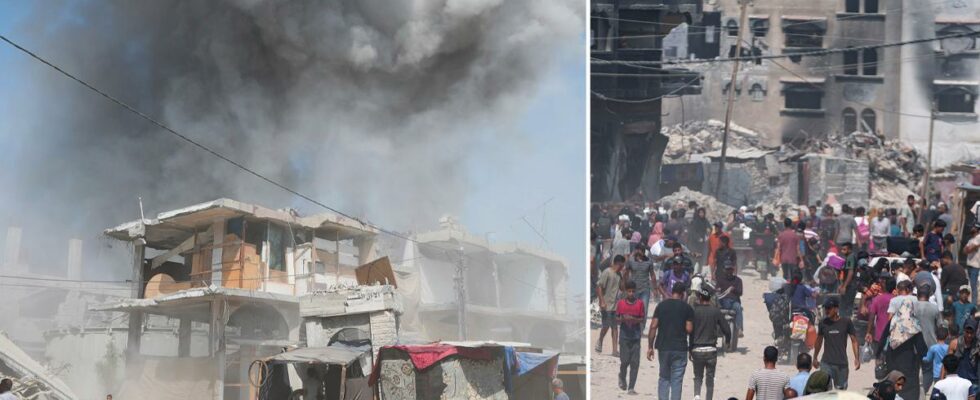unsaveSave
Once again, the Israeli military, the IDF, is calling on Palestinian civilians to flee.
This time, the evacuation order concerns an area within the “humanitarian” zone designated by the IDF.
Meanwhile, the total death toll in Gaza exceeds 39,000 people, according to the Gaza Ministry of Health.
On Monday morning, Israel’s military, the IDF, issued yet another evacuation order to civilians in southern Gaza. The “humanitarian zone” al-Mawasi has been “adjusted”, the IDF writes in one posts on X.
Israel is to carry out “powerful operations” in the eastern parts of Khan Yunis, the IDF wrote, claiming, among other things, that rockets were fired from the area.
About three hours later, the first reports of fatal attacks came.
At 10.30 on Monday morning, medical staff at Nasser Hospital in Khan Yunis announced that 27 people had been killed.
By Monday afternoon, the death toll had risen to at least 37 people.
expand-left
full screen Attack on Khan Yunis on Monday. Photo: Abdel Kareem Hana / AP
High risk of Polio
The UN, a range of aid organizations and Palestinians in Gaza have long said there is no safe place within the besieged strip of land.
The UN estimates that up to 1.5 million people are now in the so-called humanitarian zone around the coastal area of al-Mwasi. It too has been subjected to Israeli bombardment several times.
Last month, around 90 Palestinians were killed there.
At the same time, diseases are spreading “out of control” in Gaza, according to the World Health Organization WHO.
– It was sadly expected because the entire population of Gaza has been deprived of important medical care aimed at preventing and controlling the spread of diseases for over nine months, says spokesperson Christian Lindmeier to AFP.
Yesterday, the IDF announced that Israeli soldiers are to be vaccinated against polio, after high concentrations of the highly contagious virus were found in the Gaza sewage system.
39,000 killed
“Palestinians in Gaza are forced to move like human pinballs through a landscape full of destruction and death. No place is safe. Everything is a potential death zone,” said the UN Secretary-General António Guterres in early June.
In the past month, the IDF has urged hundreds of thousands of Palestinians to flee both Khan Yunis, Rafah and Gaza City. On July 9, the UN Office for Human Rights condemned the evacuation orders.
On Monday, the total death toll in Gaza exceeded 39,000 people, according to the health ministry in the Hamas-controlled strip of land.
expand-left
full screen There are around 400,000 Palestinians in the area. Photo: Abdel Kareem Hana / AP
“We are tired”
In the area to which Monday’s evacuation order applies, there are around 400,000 Palestinians, who are now forced to flee – often on foot.
– We are tired, says Ahmed Sammour to Reuters.
He is now at Nasser Hospital and has previously lost relatives in Israeli bombings in eastern Khan Yunis. Every day our children are killed, Ahmed Sammour told the news agency.
After the morning evacuation order, there was not enough time to escape before the first Israeli attack hit the area, he adds.
– No one told us to evacuate. They let four stories collapse on civilians.
THE FACTS Al-Mawasi
Al-Mawasi is originally a Palestinian Bedouin community on the southern Mediterranean coast of the Gaza Strip, west of the city of Khan Yunis.
The area is approximately one kilometer wide and 14 kilometers long. Before Israel declared war on Hamas after the terror-classified organization’s attacks in Israel last year, a few thousand residents lived there.
Israel’s military has designated al-Mawasi a so-called humanitarian, safe, zone. Since October 2023, Palestinian civilians have been repeatedly called to flee there.
Al-Mawasi consists mostly of sand dunes and barren farmland. Basic infrastructure such as roads, water and sewage systems are largely missing. The tents and temporary housing that have been set up offer scant protection from cold, rain, heat and sea winds. Electricity, food and clean drinking water are described as scarce goods.
According to the BBC, chicken pox, lice, diarrhea and intestinal infections spread among al-Mawasi’s large child population. Malnutrition is widespread.
Source: TT
Read more
